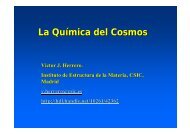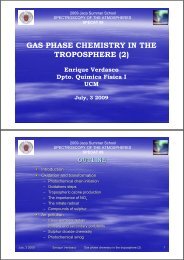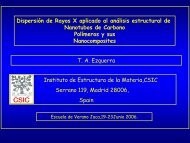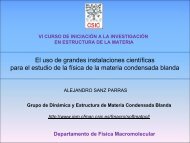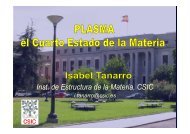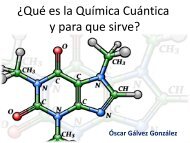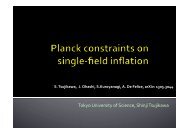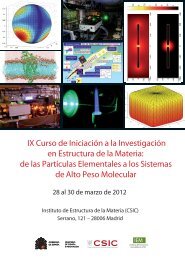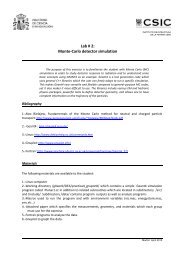Introduction to the atmosphere
Introduction to the atmosphere
Introduction to the atmosphere
You also want an ePaper? Increase the reach of your titles
YUMPU automatically turns print PDFs into web optimized ePapers that Google loves.
<strong>Introduction</strong> <strong>to</strong> <strong>the</strong> <strong>atmosphere</strong>1. Some features of <strong>atmosphere</strong>s2. The Earth’s <strong>atmosphere</strong>1. Composition, Layers and bounds2. Radiation budget, circulation and chemistry.3. Origin and evolution of <strong>the</strong> <strong>atmosphere</strong>3. A brief look at o<strong>the</strong>r <strong>atmosphere</strong>s in <strong>the</strong> SolarSystem4. The HeliosphereVíc<strong>to</strong>r J. Herrerovherrero@iem.cfmac.csic.es
Atmosphere• “Gaseous envelope surrounding a celestial body andretained <strong>to</strong> it by gravity”
Pressure and gravity• Gravity imposes a roughly exponential decline of pressure(or density) with height:p⎛ mgz ⎞z= ⎜ − ⎟ ⎜⎝ kT ⎠ ⎝ l⎛ ⎞( z) p(0)exp= p(0)exp − ⎟ ⎠z is <strong>the</strong> altitudel is a characteristic scale heightl=(kT/mg )In <strong>the</strong> troposphere l ≈ 8.5 km
Gravity and escape• Molecules can escape <strong>the</strong> upper <strong>atmosphere</strong> of a body if<strong>the</strong>ir kinetic energy exceeds <strong>the</strong>ir gravitationalattraction (Jeans escape)• The escape velocity at <strong>the</strong> exobase (i.e. at <strong>the</strong> altitudewhere collisions become negligible) is given by:v es= 2grFor <strong>the</strong> Earth:v es ≈ 11.2 km s -1• Diffusion can often limit <strong>the</strong> access <strong>to</strong> <strong>the</strong> exobase
Gravity and escapeEscape velocityv es (km/s) v es /6Earth 11.2 1.87Moon 2.4 0.4Jupiter 59.5 9.9Related escape mechanisms:Average speed (km/s)100 K 300 K 1500 KH 2 1.02 1.77 3.96CH 4 0.36 0.62 1.40N 2 0.27 0.47 1.06Light species can drag heavy molecules and help <strong>the</strong>mescape (hydrodinamic escape)Fast a<strong>to</strong>ms or molecules can be produced by charge exchangein collisions with ions
Atmospheres
The Earth’s <strong>atmosphere</strong>:CompositionDry air:Gas %N 2 78.08O 2 20.95Ar 0.93CO 2 0.038•Trace gases : noble gases, CH 4 , H 2 , NH 3 , O 3 , N and S oxides …• Water vapour: 1‐4%• Particulate matter• Clouds (water droplets, ice particles)•Aerosols•Primary (dust, sea‐salt, volcanic ashes, soot)•Secondary (H 2 SO 4 , sulphates, nitrates, organic matter)
The Earth’s <strong>atmosphere</strong>:Layers
Troposphere• Temperature drops with height (≈‐6.5 K/km) .• Located between surface (T≈ 300 K) and tropopause (9‐18 km,p ≈ 200 mbar, T≈ 210 K), where <strong>the</strong> temperature drop s<strong>to</strong>ps.• Contains 80% of <strong>the</strong> <strong>to</strong>tal atmospheric mass and 99% ofwater and particualte matter.• Divided in<strong>to</strong> two regions:• Boundary layer: quiet region, close <strong>to</strong> <strong>the</strong> surface (< 1 km).• Free troposphere: turbulent region, between boundarylayer and tropopause.
Stra<strong>to</strong>sphere• Temperature increases with height (≈ 2 K/km), due <strong>to</strong> ozonepho<strong>to</strong>chemistry• Located between tropopause (9‐18 km, p≈ 200 mbar, T≈ 210 K)and stra<strong>to</strong>pause (≈50 km, p ≈ 1 mbar, T≈ 270 K )• Thermal inversion hampers vertical air movements and leads <strong>to</strong>stratification• The tropopause is an effective (but not impermeable) barrier fortransport between troposphere and stra<strong>to</strong>sphere.
Mesosphere• Temperature drops with altitude (≈‐3 K/km)• Located between stra<strong>to</strong>pause (≈ 50 km, p ≈ 1 mbar, T≈ 270 K)and mesopause (≈ 80‐90 km, p ≈ 1 μbar, T≈ 170 K)• The mesopause is <strong>the</strong> coldest place in <strong>the</strong> <strong>atmosphere</strong>.• The highest atmospheric clouds (noctiluent clouds) are formedin this region.
Thermosphere• Characterized by a rapid temperature increase (≈ 10‐20 K/km)with height due <strong>to</strong> O 2 pho<strong>to</strong>dissociation.• Located between mesopause (≈ 80‐90 km, p ≈ 1 μbar, T≈ 170 K)and <strong>the</strong>rmopause ( 400‐1000 km, daytime T≈ 600‐2000 K)• Properties very sensitive <strong>to</strong> <strong>the</strong> insolation received• Density very low. The International Space Station operates inthis region (≈ 350 km)
Exosphere• Starts at <strong>the</strong> exobase (400‐1000 km), where collisionsbecome negligible.• H and He a<strong>to</strong>ms begin <strong>to</strong> dominate.• Its upper limit is ill defined
Atmospheric bounds• The <strong>atmosphere</strong> has no clear bounds. There is a gradualtransition between <strong>atmosphere</strong> and “outer space”• For certain purposes limits can be defined.Magne<strong>to</strong>pause:(> 60,000 km)Influence of Earth oncharged particlesKármán Line(100 km)Viscous effects inaeronautics.
Radiation budget•The solar radiation is partlyreflected and partly absorbedand re‐emitted by <strong>the</strong> Earth.•The emission spectrum of <strong>the</strong>Sun has a maximum in <strong>the</strong>visible•The emission spectrum of <strong>the</strong>Earth has a maximum in <strong>the</strong> IR
Radiation budget :Temperature of <strong>the</strong> EarthAbsorbed incoming radiation:Emitted radiationS: solar constantA: average albedo(Stefan‐Boltzmann)Emission temperatureT e ≈ 254 K in accord withsatellite measurements, but <strong>the</strong>average temperature at <strong>the</strong>Earth´s surface is ≈ 288 K
Greenhouse effectGasContribution <strong>to</strong>T increase (K)H 2 O 20.6 62CO 2 7.2 22O 3 trop. 2.4 7N 2 O 1.4 4CH 4 0.8 2.5O<strong>the</strong>r ≈ 0.6 2.5Sum 33 100Contribution <strong>to</strong>greenhouseeffect (%)Part of <strong>the</strong> energyIs absorbed by gasesin <strong>the</strong> lower<strong>atmosphere</strong> and reemitted<strong>to</strong>wards <strong>the</strong>surface
Atmospheric circulation• Buildup of convective cells
Atmospheric circulation• Coupling of convection and Coriolis forces
Atmospheric chemistry• Is driven by <strong>the</strong> small UV component of <strong>the</strong> Sun’sradiation• Has distinct characteristics in <strong>the</strong> various layers• Troposphere: Dominated by oxidation processes• Stra<strong>to</strong>sphere: Ozone chemistry• Thermosphere: Significant dissociation and ionization(ionosphere)The most complex atmospheric chemistry takes placein <strong>the</strong> tropospheric boundary layer
Tropospheric Chemistry• Oxidation reactions• Main daytime oxidant: OH radical, produced by:• O 3 +hν (λ>290 nm) → O( 1 D) +O 2• O( 1 D) + H 2 O → 2 OH• Main oxidant at night: NO 3radical, produced by:• O 3 + NO 2 → NO 3 + O 2
Tropospheric chemistry:urban smog•“London type”•Reducing character•Sulphur compounds•“Los Angeles type”•Pho<strong>to</strong>chemical•Oxidizing character•NO x and VOCs
Urban smog: Madrid
• Ozone pho<strong>to</strong>chemistry• “Oxygen only” cycle :• O 2 + hν (λ
The ionosphere• A<strong>to</strong>mic ions• Molecular ions• Cluster ions
Ions at high latitudes• Close <strong>to</strong> <strong>the</strong> poles, charged particles can enter and leave<strong>the</strong> <strong>atmosphere</strong> along open magnetic lines• Polar wind: net outflow of ions (H + , He + , O + )• Polar aurorae: collisions of solar wind particles (mostlyelectrons) with a<strong>to</strong>ms and molecules (≈ 100 km)
Evolutionof <strong>the</strong>Earth’s<strong>atmosphere</strong>• Primieval <strong>atmosphere</strong> ?• Formed <strong>to</strong>ge<strong>the</strong>r with <strong>the</strong> planet (≈ 4500 Myr bp)• Species from <strong>the</strong> original nebula• Unlikely retention of H 2 and He (<strong>to</strong>o light)• Main volatiles light hydrogenated compounds (CH 4 , NH 3 ,H 2 O)•Present iso<strong>to</strong>pic abundance on Earth very different from<strong>the</strong> solar nebulaThe original <strong>atmosphere</strong> was lost (enhancedsolar wind, heat liberated in gravitationalcollapse…)
Evolution of <strong>the</strong> Earth’s<strong>atmosphere</strong>• Secondary <strong>atmosphere</strong>• generated by outgassing• Probably formed by H 2 O and CO 2• Minor gases: NH 3 , CH 4 , N 2 …• Planet cooling → condensation of H 2 O→ oceans• CO 2 + H 2 O (liquid) → sedimentary carbonates (3800 Myr bp)• CH 4 and NH 3 are pho<strong>to</strong>lyzed (NH 3 → N 2 )With most H 2 O and CO 2 in condensedphases, <strong>the</strong> dominant atmospheric gas3800 Myr bp was probably N 2
Evolution of oxygen and lifeMost atmospheric O 2 was produced by pho<strong>to</strong>syn<strong>the</strong>sisFe 2+ →Fe 3+
Planets• Rocky planetsIce line• Formed below <strong>the</strong> frost line (≈ 3 AU)• Rich in metal and silicates. Small sizes• Unable <strong>to</strong> retain H 2 or He. Thin <strong>atmosphere</strong>s• Gaseous planets• Formed beyond <strong>the</strong> frost line• Condensation of volatiles. Large sizes• Large <strong>atmosphere</strong>s of H 2 and He
Atmosphere of Venus• Composed of CO 2 (96%) and N 2 (3%)• Minor gases: SO 2 , H 2 O, CO• H 2 SO 4 clouds• Surface temperature: 700 K• Surface pressure: 90 bar• “Superrotation” of zonal windsVery large greenhouse effect
Atmosphere of Mars• Composed of CO 2 (96%) and N 2 (3%)• Minor gases: O 2 , H 2 O, CH 4• some H 2 O and CO 2 trapped in ice caps• Average surface temperature: 227 K• Surface pressure: 6 mbar• Wind and dust s<strong>to</strong>rms
Atmospheres of <strong>the</strong> rocky planetsVenus Earth Mars
Atmosphere of Titan• Composed of N 2 (96%) and CH 4 (5% at surface)• Minor gases: CO, CO 2 , H 2 O, hydrocarbons• Pho<strong>to</strong>chemical aerosol layer of organic compounds• Average surface temperature: 94 K• Surface pressure: 1.5 barPossibly similar <strong>to</strong> some stage of <strong>the</strong> primitiveEarth’s <strong>atmosphere</strong> in composition andpressure
Atmospheres of <strong>the</strong>gaseous giants• Mostly composed of H 2and He• Minor gases: H 2O, NH 3, CH 4• Large and dense <strong>atmosphere</strong>s• Probably no definite surface• Presence of clouds and pho<strong>to</strong>chemical aerosols
Atmospheres of Jupiter and Saturn
Atmospheres of Uranus andNeptune“Icy giants”UranusNeptune
Solar wind andheliosphere• The solar wind is a stream of highly energetic particles(mostly electrons and pro<strong>to</strong>ns) emitted by <strong>the</strong> Sun.• The expansion of <strong>the</strong> solar wind ends in a shock structure.The region of space within this shock structure is called<strong>the</strong> heliosphere. It is a kind of very thin “<strong>atmosphere</strong>” for<strong>the</strong> whole Solar System.• The termination shock, at ≈ 90 AU, has been recentlyaccessed by <strong>the</strong> Voyager 1 and Voyager 2 space missions.
Back <strong>to</strong> Earth!




